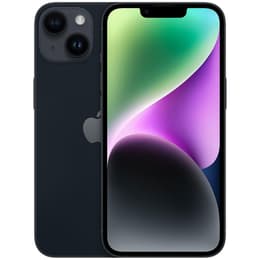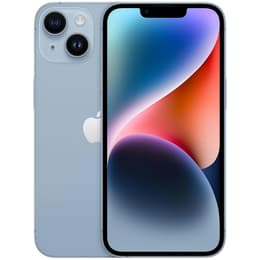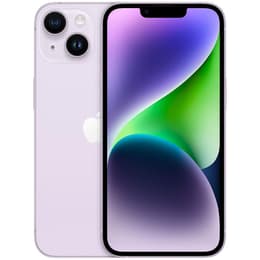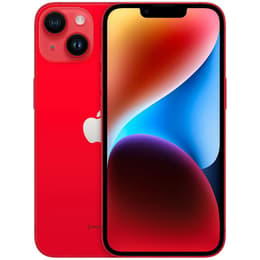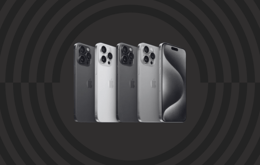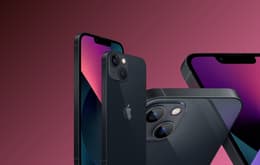

By selecting “Accept all” you allow Back Market and our partners to use cookies and to share your data for all these purposes. We and our partners use cookies and similar tools to measure our site's audience, evaluate the performance of our ads, and show you personalized content and ads.
Except for cookies that are essential for navigating our site, we use these cookies and share your data only with your consent. Learn more about cookies. You can change your mind and modify your choices at any time by going to the "Cookies and privacy settings" section at the bottom of any page. Read our Cookie policy and Data Protection Policy for more info.
iPhone 14 review in 2025: is it still worth it?
Updated on 16 May 2025
16 May 2025
9 mins read
Haziq
Tech Expert for Back Market UK, Ireland & Australia
The iPhone 14 was a solid device when Apple released it in 2022, but is it still a smart buy in 2025? With the iPhone 15 dominating the spotlight and the iPhone 16's recent release, let’s take a closer look at whether the iPhone 14 still holds its value or if it’s worth waiting for prices to drop further.
BOTTOM LINE
💗💗💗🤍🤍 3/5: Good

How does the iPhone 14 stack up against the iPhone 15?
The iPhone 14 compared to the 13 was essentially a refined version of its predecessor, with modest improvements, particularly in the camera department. But when we compare it to the iPhone 15, the differences start to become more apparent.
Price:
First things first, surprisingly, the iPhone 14's initial release price was higher than that of the iPhone 15. Brand new, the iPhone 14 started at £849, which is £50 cheaper than the iPhone 15 at £799. Alternatively, if you buy refurbished from Back Market, the iPhone 14 will cost starting at £274 compared to iPhone 15 starting around £441.
Design & display:
The iPhone 14 retains the classic Apple design, with its 6.1-inch Super Retina XDR OLED display and a Ceramic Shield front. It’s still a visually appealing device, but the iPhone 15 steps things up with slightly thinner bezels, a new Dynamic Island, and a USB-C port replacing the Lightning connector. These updates, while incremental, give the iPhone 15 a more modern feel, especially when considering future compatibility with accessories.
Performance:
The iPhone 14’s A15 Bionic chip, inherited from the iPhone 13 Pro, offers solid performance that remains competitive even in 2024. However, the A16 Bionic chip in the iPhone 15 provides a noticeable speed boost, particularly in graphics-heavy applications and multitasking. For most users, the increase in performance speed isn't going to make any difference, but if you have a need for faster processing, the iPhone 15 is a clear winner.
Camera:
The camera system is where the iPhone 14 still shines. With its improved low-light performance and the introduction of the Photonic Engine, it captures stunning photos and videos. The iPhone 15, however, introduces a more advanced 48MP main camera (previously seen in the iPhone 14 Pro), offering greater detail and flexibility, especially with its ability to shoot in ProRAW. If photography is a key consideration, the iPhone 15 offers more, but the iPhone 14 is still more than capable for everyday use.
Battery Life & Charging:
While the iPhone 14’s battery life was a slight improvement over the iPhone 13, it lags behind the iPhone 15. The iPhone 15 offers better battery efficiency thanks to the A16 chip and comes with slightly faster charging capabilities. If you’re someone who’s constantly on the go, the iPhone 15 might offer the longevity you need.
iPhone 14 specifications

Let's start with a quick overview of the iPhone 14 technical specifications. Overall, the iconic smartphone offers much the same in terms of internals as its predecessor, the iPhone 13. The two generations use the same core processor (the A15 Bionic chip) and offer the same storage options (128 GB, 256 GB, and 512 GB), with the iPhone 14 providing more RAM (6 GB versus 4 GB in the 13), similar battery (the iPhone 14 plays 1 hour longer), and so on.
It’s pretty much the same with the body of these two phones. The camera is somewhat better on the iPhone 14 (due mainly to internals and software; the hardware is identical). The display, too, is the same on both phones. It only gets an upgrade (a small one) on the iPhone 15. All three phones feature the same Ceramic Shield front and glass back.
Here are the iPhone 14 technical specs in more detail:
iPhone 14 (base model) | Specs |
|---|---|
Body Dimensions | 146.7 x 71.5 x 7.8 mm |
Weight | 172g |
Build | Glass-front and glass-back, aluminium frame |
IP Rating | IP68 dust/water resistant |
SIM | Nano-SIM and eSIM - International |
Colours | Midnight, Purple, Starlight, Blue, Red |
Display | 6.1-inch (diagonal) all-screen Super Retina XDR OLED |
Resolution | 1170 x 2532 pixels, 19.5:9 ratio (~460 ppi density) |
Brightness | 1,200-nits |
Protection | Ceramic Shield glass |
Performance Processor | A15 Bionic |
GPU | Apple-designed 5-core |
CPU | 6-core CPU |
RAM | 6GB |
Storage | 128GB, 256GB, 512GB |
Camera | Dual camera: 2 MP, f/1.5, 26mm (wide), 1/1.7", 1.9µm, dual pixel PDAF, sensor-shift OIS 12 MP, f/2.4, 13mm, 120˚ (ultrawide) |
Camera Features | Dual-LED dual-tone flash, HDR (photo/panorama) |
Video | Dolby Vision HDR up to 4K at 60fps |
Selfie Camera | 12 MP, f/1.9, 23mm (wide), 1/3.6", PDAF SL 3D, (depth/biometrics sensor) |
Selfie Camera Features | HDR, Cinematic mode (4K@30fps) |
Selfie Video | 4K at 24/25/30/60fps, 1080p at 25/30/60/120fps, gyro-EIS |
Battery Life | Up to 20 hours of video playback |
Battery Capacity | Li-Ion 3279 mAh, non-removable (12.68 Wh) |
Model Features | Face ID, Barometer, High dynamic range gyro, High-g accelerometer, Proximity sensor, Dual ambient light sensors |
Sound | Stereo speakers with no headphones jack |
Price Apple Store (New) | Prices starting from £699 |
Back Market Price (refurbished) | Prices starting as low as £400 |
👉 Check out our helpful guide on how to choose the right storage capacity for your iPhone 14 model.

Should I wait for the iPhone 14 price to drop?
If you don't have any immediate need to replace your current phone, your best bet to save money is to wait a few months for the iPhone 14 price to drop. Right now, you can find one at a great starting price of £274 on Back Market, but we expect that price to continue dropping, with a sharp decrease after the iPhone 17 is released in September.
The iPhone 14 price already dropped an average of about £100 after the iPhone 16 was released 8 months ago, so you can expect a similar trend for older iPhone models, including the 15, this year.
Of course, if you need a replacement phone more immediately, then the current iPhone 14 prices still offer a great value.
Alternative options to the iPhone 14
Today, the smartphone market offers plenty of alternatives to the iPhone 14, especially as prices fluctuate.
iPhone 13 Pro: If you’re looking for a more premium experience at a lower cost, the iPhone 13 Pro is a strong contender. It offers a ProMotion display, superior camera capabilities, and better build quality compared to the iPhone 14, making it a better option for most average iPhone users.
iPhone 15: If you’re willing to spend a bit more, the iPhone 15 offers more future-proofing with its updated design, improved performance, and better camera system. Some people may find it well worth it at a similar price point as the 14.
Refurbished iPhone 14 Pro: The iPhone 14 Pro is a more similar smartphone to the iPhone 15, but for a slightly lower average cost. For those who prioritize camera quality and a smoother display, a refurbished iPhone 14 Pro could be a great middle ground.
Android smartphones: If you’re open to switching ecosystems, there are numerous Android devices that offer excellent value in 2025. Samsung’s Galaxy S23 and Google’s Pixel 7 series, for example, are strong contenders with top-tier specs and competitive pricing.
Repairability and Sustainability
The Right to Repair has been on centre stage in recent years, and justly so. Electronics are both expensive and increasingly important in our day-to-day lives, and the realities of planned obsolescence and deliberately unrepairable design mean that we produce a stunning amount of e-waste AND we pay a high financial cost to replace devices that should be fixable. And Apple is supposedly a supporter of customers’ right to repair their devices.
To that end, Apple made the iPhone 14 much easier to repair than its previous generation, at least in the mechanical sense. But the tech giant also used a software limiting technique called parts pairing to keep just anyone from repairing their iPhone without a genuine (and costlier) Apple part AND without informing Apple first. (Read about it on iFixit.) So for the time being, no recent iPhone - not the 13, not the 14, and not the 15 - is easy to repair, unless you are a specially certified repair shop. Which means customers are more likely to get rid of an older phone and buy a new one, creating more e-waste.
One solution that can help you save more while essentially reusing phones that would otherwise have been trashed is to buy a refurbished iPhone from a reputable supplier like Back Market.
Though the products on BackMarket.co.uk and similar sites are used or otherwise pre-owned, they have been professionally repaired, cleaned and tested, and work just as well as new ones, with no compromise on performance. Whether they are unused customer returns, defective products returned under warranty, display items, demonstration products, or goods returned because they or their packaging were damaged in shipping--they don’t go up for sale until we have ensured that they work like new.
What’s more, with Back Market, you'll also get free standard shipping, a 1-year warranty and 30 days to change your mind with every purchase, so there's little risk when compared to buying new. Opting for second-hand products also means you’re doing your part in supporting less waste to prevent further environmental damage.
Final verdict: is the iPhone 14 worth it?
So, is the iPhone 14 worth it in 2025? The answer largely depends on your needs and budget. Since the iPhone 16 was released 8 months ago, you're likely to find great deals on the iPhone 14, which is still a highly capable device that will serve you well for years to come. However, if you’re looking for the latest features, better performance, and enhanced camera capabilities, it might be worth spending a bit more on the iPhone 15.
Ultimately, the iPhone 14 remains a solid choice, but with new models and price drops on the horizon, timing your purchase wisely could save you money while still getting a great phone. If you need a replacement iPhone more immediately, then you might be better off with an alternative, lower cost option like the iPhone 13 or 13 Pro.
What our experts think
Our in-house tech expert and Lead Refurbishment & Operations Manager, Kewin Charron, weighs in with his thoughts of the iPhone 14:
Overall, the iPhone 13 Pro is a better deal than the iPhone 14. It has the same performance and better camera features, offering great value for your money.

Written by Haziq, Tech Expert for Back Market UK, Ireland & Australia
When not fighting the good fight for environmental sustainability, Haziq loves making reviews of everything and anything tech-related.

